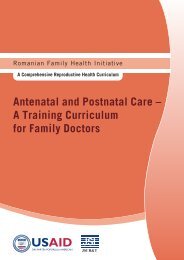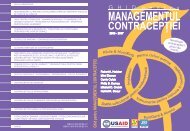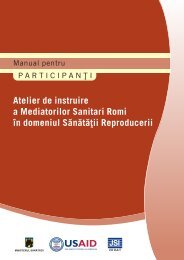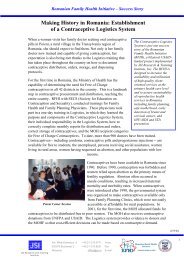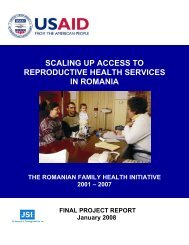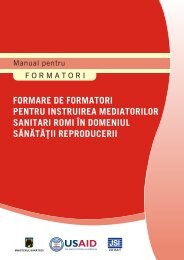Training of Roma Health Mediators in Reproductive Health
Training of Roma Health Mediators in Reproductive Health
Training of Roma Health Mediators in Reproductive Health
Create successful ePaper yourself
Turn your PDF publications into a flip-book with our unique Google optimized e-Paper software.
Tra<strong>in</strong>er document<br />
NORMAL CHANGES DURING THE POSTPARUM PERIOD<br />
Physical Changes<br />
A woman's body will never be exactly as it was before pregnancy. Some changes <strong>in</strong> the<br />
reproductive system are ever last<strong>in</strong>g changes. Body shape and weight come back to<br />
normal sooner if she breastfeeds her baby for a longer period <strong>of</strong> time.<br />
Body weight starts to be lost immediately after delivery; a woman loses about 5-7 kilos<br />
dur<strong>in</strong>g delivery and cont<strong>in</strong>ues to lose weight <strong>in</strong> the follow<strong>in</strong>g months, especially if she is<br />
breastfeed<strong>in</strong>g her baby.<br />
<strong>Reproductive</strong> organs:<br />
• Uterus shr<strong>in</strong>ks and sheds its l<strong>in</strong><strong>in</strong>gs<br />
Immediately after delivery, the uterus is still quite large and can be felt <strong>in</strong> the lower<br />
abdomen as a hard and round mass. It soon beg<strong>in</strong>s to get smaller <strong>in</strong> size due to<br />
contractions. These may be pa<strong>in</strong>ful (like periods) for the first couple <strong>of</strong> days.<br />
Breastfeed<strong>in</strong>g helps the uterus to contract properly: it reduces the amount <strong>of</strong> fluid that<br />
comes out after delivery and it helps the uterus to recover its shape and size.<br />
• Vag<strong>in</strong>al secretion decreases and changes.<br />
Fluids com<strong>in</strong>g out <strong>of</strong> the uterus and pass<strong>in</strong>g through vag<strong>in</strong>a are called lochia. This is<br />
bright red immediately after delivery because it conta<strong>in</strong>s mostly blood for the first few<br />
days. Gradually its color changes to dark brown and then to pale cream. The amount <strong>of</strong><br />
discharge becomes smaller over time and then completely stops, usually by the end <strong>of</strong> the<br />
fourth week.<br />
• Changes <strong>in</strong> the breast<br />
After childbirth, the breasts start produc<strong>in</strong>g milk. The milk secretion is established<br />
properly with<strong>in</strong> a couple <strong>of</strong> days, especially if the baby is put to the breast with<strong>in</strong> an hour<br />
<strong>of</strong> delivery and suckles regularly. The first milk, called colostrum, is thick and yellowish<br />
and is very good for the baby. Soon it becomes th<strong>in</strong> and white.<br />
• Return <strong>of</strong> menstruation<br />
The time it takes for menstrual periods to return follow<strong>in</strong>g childbirth may vary from one<br />
pregnancy and delivery to another. If a woman breastfeeds exclusively, without giv<strong>in</strong>g<br />
her baby any other milk, her periods may not return for six or more months after delivery.<br />
If she is not breastfeed<strong>in</strong>g, menstruation usually beg<strong>in</strong>s 4-6 weeks after delivery.<br />
Abdomen returns gradually to its normal size.<br />
Other changes that occurred dur<strong>in</strong>g pregnancy (respiratory, blood, renal systems)<br />
disappear several days after childbirth.<br />
The sk<strong>in</strong> darkness (on face, breast, abdomen) lasts for a few weeks or months.<br />
Emotional Changes<br />
As childbirth is a deeply emotional experience, it <strong>of</strong>ten affects the mood and behavior <strong>of</strong><br />
the woman. She may feel happy and relaxed one m<strong>in</strong>ute and anxious, depressed, or<br />
tearful the next. She needs support, understand<strong>in</strong>g and reassurance from her husband,<br />
other family members and friends.<br />
126<br />
RFHI/JSI <strong>Roma</strong>nia <strong>Tra<strong>in</strong><strong>in</strong>g</strong> <strong>of</strong> RHMs <strong>in</strong> <strong>Reproductive</strong> <strong>Health</strong> Session 7: Postpartum Care



